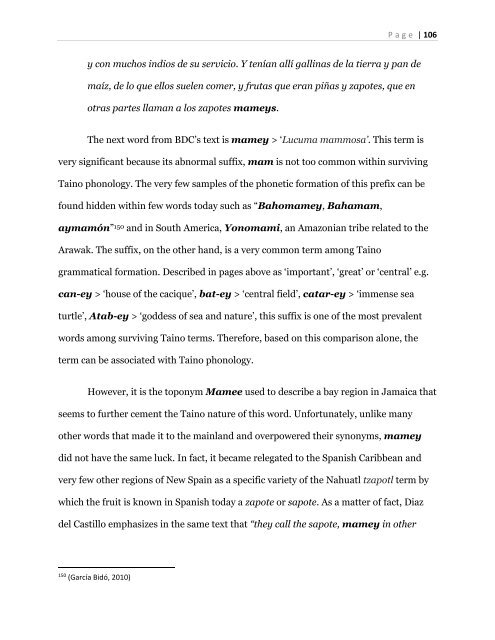Language of the Voiceless: Traces of Taino Language, Food, and Culture in the Americas From 1492 to the Present
by Leonardo Nin
by Leonardo Nin
Create successful ePaper yourself
Turn your PDF publications into a flip-book with our unique Google optimized e-Paper software.
P a g e | 106<br />
y con muchos <strong>in</strong>dios de su servicio. Y tenían allí gall<strong>in</strong>as de la tierra y pan de<br />
maíz, de lo que ellos suelen comer, y frutas que eran piñas y zapotes, que en<br />
otras partes llaman a los zapotes mameys.<br />
The next word from BDC’s text is mamey > ‘Lucuma mammosa’. This term is<br />
very significant because its abnormal suffix, mam is not <strong>to</strong>o common with<strong>in</strong> surviv<strong>in</strong>g<br />
<strong>Ta<strong>in</strong>o</strong> phonology. The very few samples <strong>of</strong> <strong>the</strong> phonetic formation <strong>of</strong> this prefix can be<br />
found hidden with<strong>in</strong> few words <strong>to</strong>day such as “Bahomamey, Bahamam,<br />
aymamón” 150 <strong>and</strong> <strong>in</strong> South America, Yonomami, an Amazonian tribe related <strong>to</strong> <strong>the</strong><br />
Arawak. The suffix, on <strong>the</strong> o<strong>the</strong>r h<strong>and</strong>, is a very common term among <strong>Ta<strong>in</strong>o</strong><br />
grammatical formation. Described <strong>in</strong> pages above as ‘important’, ‘great’ or ‘central’ e.g.<br />
can-ey > ‘house <strong>of</strong> <strong>the</strong> cacique’, bat-ey > ‘central field’, catar-ey > ‘immense sea<br />
turtle’, Atab-ey > ‘goddess <strong>of</strong> sea <strong>and</strong> nature’, this suffix is one <strong>of</strong> <strong>the</strong> most prevalent<br />
words among surviv<strong>in</strong>g <strong>Ta<strong>in</strong>o</strong> terms. Therefore, based on this comparison alone, <strong>the</strong><br />
term can be associated with <strong>Ta<strong>in</strong>o</strong> phonology.<br />
However, it is <strong>the</strong> <strong>to</strong>ponym Mamee used <strong>to</strong> describe a bay region <strong>in</strong> Jamaica that<br />
seems <strong>to</strong> fur<strong>the</strong>r cement <strong>the</strong> <strong>Ta<strong>in</strong>o</strong> nature <strong>of</strong> this word. Unfortunately, unlike many<br />
o<strong>the</strong>r words that made it <strong>to</strong> <strong>the</strong> ma<strong>in</strong>l<strong>and</strong> <strong>and</strong> overpowered <strong>the</strong>ir synonyms, mamey<br />
did not have <strong>the</strong> same luck. In fact, it became relegated <strong>to</strong> <strong>the</strong> Spanish Caribbean <strong>and</strong><br />
very few o<strong>the</strong>r regions <strong>of</strong> New Spa<strong>in</strong> as a specific variety <strong>of</strong> <strong>the</strong> Nahuatl tzapotl term by<br />
which <strong>the</strong> fruit is known <strong>in</strong> Spanish <strong>to</strong>day a zapote or sapote. As a matter <strong>of</strong> fact, Diaz<br />
del Castillo emphasizes <strong>in</strong> <strong>the</strong> same text that “<strong>the</strong>y call <strong>the</strong> sapote, mamey <strong>in</strong> o<strong>the</strong>r<br />
150<br />
(García Bidó, 2010)


















